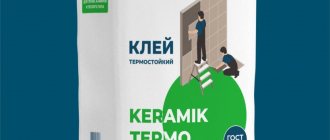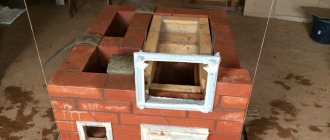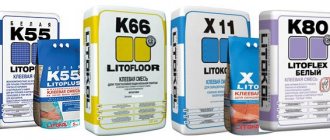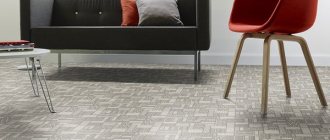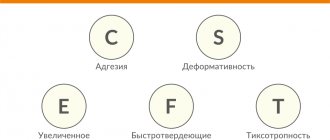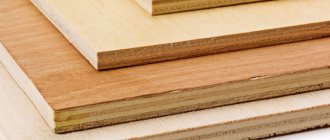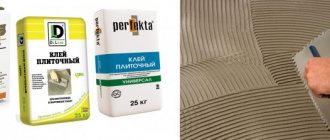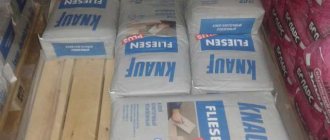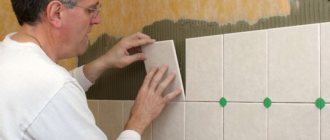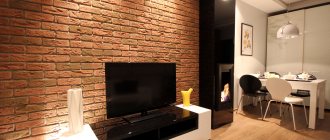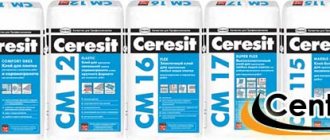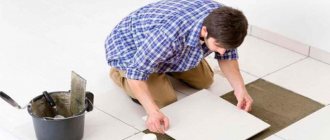- Types of glue
- By type of binder
- By area of application
- Official classification according to GOST R 56387—2015 (markings)
- Choosing a tile adhesive: points to consider
- Base type
- Tile material
- Tile size
- terms of Use
- Rules for working with tile adhesive
- How to calculate the amount of glue
- How to properly dilute and replace glue
- How to apply tile adhesive correctly
- What thickness of tile adhesive is considered optimal?
- Answers to frequently asked questions
Tiles are widely used in construction for interior and exterior walls and floors. Tile adhesive is used for its installation. Which tile adhesive is best to choose depends on:
- tile material and size,
- type of base,
- characteristics of the work site.
Regardless of the type, tile adhesive has three functions:
- provides high adhesion (adhesion) to the base and surface of the tile;
- prevents tiles from moving after installation;
- retains its properties for a long time under the influence of external factors.
Composition of tile adhesive
In terms of high consumer and performance characteristics, ceramic tiles have no competitors. It is durable, wear-resistant, beautiful and affordable. This is an ideal option for finishing bathrooms and toilets. Indoors, tiles are often placed on floors and walls - they can withstand any load and do not require careful maintenance. As an external decoration, tiles are widely used for cladding the basement and facades of buildings. Here it also performs well - it is not afraid of sudden temperature changes, is inert to moisture and wind, lasts a long time and does not lose its attractive appearance.
Each type of tile requires a special adhesive to work. The choice of tile adhesive depends on the following factors:
- where it will be installed - inside or outside;
- on what surface - flat or curved;
- tile format - standard or non-standard;
- conditions of work performed and future operation.
Advice When working with large-format tiles, heavy porcelain tiles or natural stone, reinforced adhesives should be used outside and inside buildings. For laying tiles on a flat surface, tile adhesive with a simple composition is suitable. For cladding geometrically complex structures, it is better to use a special elastic mortar that can withstand extreme conditions of compression and expansion.
Floor porcelain tiles or heavy tiles are laid using special types of glue that have a two-component composition that increases the adhesion, heat resistance and moisture resistance of the cladding. For baths, saunas and swimming pools, a waterproof adhesive solution is used, which ensures long service life and strength of the material provided that it is in constant contact with water.
Advice The most famous is cement-based tile adhesive. Its composition guarantees high adhesion and plasticity; it is available in powder form.
Rules for storing the solution
Adhesives in bags should be stored in a dry room on special wooden planks. Any type of container must be tightly closed. The prepared solution cannot be used after the expiration date; it will not be able to securely hold the tiles together. Before work, the standing solution should be mixed again to restore homogeneity; cover the container with a plastic bag. Sometimes you can resort to adding water to dilute the thickened glue, but only a little.
Adhesives in bags should be stored in a dry place on special wooden planks.
There are a variety of tile adhesives produced; when choosing, you take into account the operating requirements in order to obtain a strong connection that will last for many years. You should not save money when working with large-sized slabs; only a high-quality composition can securely fix them. It is advisable to request a quality certificate from the seller before purchasing to be sure of the brand of the product.
Properties and characteristics
The consumer places the highest demands on tiles. It must be strong and durable, resistant to frost and heat, moisture, microorganisms and chemicals, temperature changes, frequent washing and exposure to sunlight. For many years, the tile covering should maintain its impeccable appearance and excellent quality, without requiring careful maintenance. Ceramic tile adhesive should maintain and improve all these properties and extend the service life of the finished tile covering.
Tile adhesive - main characteristics:
- prevention of slipping: the adhesive mixture must be resistant to movement of the tiles after installation;
- pot life: on average it ranges from 1 to 3 hours, during which the solution fully retains all its properties and qualities;
- working time: for ordinary glue this period is from 10 minutes to half an hour; the quick-drying composition allows only 5-10 minutes to lay the tiles;
- correction time: this is the time interval during which the position of the tiles relative to each other can be corrected.
The scope of application of specialized adhesives is extensive. Heat-resistant compounds are indispensable for lining heated floors, stoves and fireplaces. For constant contact with water, highly elastic, moisture-resistant adhesives are used. White glue is ideal for working with translucent and transparent mosaics. A leveling adhesive is needed for laying tiles on an unleveled base.
Basic rules at work
Successful installation is possible not only after the correct selection of glue, but also if the general rules for its use are observed. The following principles can be highlighted, since cement mixtures are more popular, the features of working with them will be taken into account:
- Creation of optimal temperature, range from +5 to +30 degrees;
- Make the required layer thickness, varies from 3-15 mm;
- On average, the solution loses its properties after 3-4 hours;
- 10 minutes are given for correction.
Make the required layer thickness, varies from 3-15 mm.
Varieties
- Cement. This is a universal adhesive composition suitable for tiles of any size for walls and floors. It is very easy to dilute it - take 1 part glue and 3 parts water. It is distinguished by its versatility, impeccable quality and competitive price.
- Polymeric. This type of glue is divided into two groups - acrylic and epoxy. The adhesive mass based on acrylic resin is immediately ready for use; it is used in areas subject to severe mechanical stress. Epoxy compounds require an accelerated pace of work, as they set instantly in the open air. This property is regarded by consumers as both an advantage and a disadvantage.
- Polyurethane . Polyurethane-based tile adhesive securely attaches to any surface, is easy to apply and has economical consumption. It is plastic and moisture resistant, retains its characteristics for a long time and can be used on complex surfaces of metal, wood, plasterboard and plywood.
- Mosaic. For mosaics, you need to use only special glue. It is distinguished by its flexible and plastic structure, as well as its white color, which creates an excellent background for glass or smalt decorative mosaics.
Advice A modern manufacturer relies on a cement adhesive for tiles. Compared to polymer and special adhesives, its price is an order of magnitude lower. The finished composition will always be more expensive than glue, which requires preliminary mixing and curing.
Right choice
The choice of tile adhesive largely depends on the specific room being renovated. A polymer adhesive would be appropriate for outdoor use; cement-based adhesive is an excellent base for kitchens and bathrooms. Which adhesive to choose from a wide range of ceramic tiles?
Before visiting a hardware store, you should decide on the following important aspects:
- Base for laying tiles. It can be concrete, plaster, brick, cement screed, drywall, plywood, paint, wood, metal and so on.
- Degree of unevenness. On unleveled surfaces, you should use a special adhesive for ceramic tiles, which is also an adhesive, sealant and leveler.
- Material for making tiles. Small, lightweight wall tiles require a minimal adhesive layer. The heavier the tile, the greater the consumption of adhesive solution.
- Sizes of tiles and decor. Deviation from the standard requires correction of the volume of glue used. Larger tiles require a thicker adhesive layer.
- Terms of Use. What range of temperature and humidity will be present in the room, what load should the tiles withstand, what care will be provided during its service life.
- Required amount of glue: the total area of the surface to be finished should be calculated and multiplied by the expected consumption of the substance. Average values are given on the packaging. Typically this figure varies in the range of 5-6 kg per 1 m².
- Peculiarities. To design heated floors, you need a special adhesive that is resistant to heating and cooling. Reinforced tile adhesive is the best choice for porcelain tiles and stone cladding.
Advice The cheapest option suitable for laying tiles on a concrete base is a homemade cement-sand mortar. The required consistency is achieved by diluting the dry base with water. For greater strength, PVA glue should be added to the mixture.
Professionals recommend choosing tile adhesive for the bathroom that spreads well and is flexible, with fungicidal and antibacterial additives that prevent the formation of mold and mildew. This is necessary for rooms with high humidity. Strictly following the manufacturer's instructions will allow you to prepare the correct solution, ensuring strong and durable fastening of the tiles in a vertical and horizontal position to any base.
How to dilute and use
Tile adhesive exists in two factory versions: in dry form, requiring preliminary preparation, and as a ready-made mixture. With the ready-made composition, everything is simple - you can open the package and immediately start working. It is recommended to use the finished mass to the end - without any residue, since it has a limited shelf life. Commercially prepared adhesives can be presented in the form of paste or mastic.
Advice If you work with tiles yourself, then it is better to choose adhesives with a high degree of plasticity and optimal spreadability. Such tile adhesives are efficiently distributed over the surface of the tile, filling the cracks and penetrating into all the voids underneath.
The basis of dry adhesives is sand and Portland cement, which give the adhesive layer strength and reliability. The main technical characteristics are provided by modifying additives. Dry tile adhesive is used as needed, the composition is mixed and consumed gradually. The correct method of use is indicated by the manufacturer on the packaging. The solutions penetrate well into the structure of the material and provide reliable adhesion of the tile to the surface. After using dry compounds, it is much easier to dismantle the tile covering.
Instructions for use
Before using Ceresit tile adhesive, you must carefully prepare the base. This is necessary in order to fully utilize the high adhesive properties of the solution. It is recommended to remove as much of the old base as possible, clean and level the surface.
Vertical surfaces should first be marked and the bar should be installed at the level of the first tile row. This will prevent the cladding from slipping during the first 6 hours of installation.
- After mixing the solution, start working immediately. Apply 200–300 g with a flat spatula. solution onto the prepared plane.
- Use a notched trowel to create a ribbed structure. The depth of the grooves is adjusted depending on the size of the tile. The smaller the tile, the less unevenness.
When using Ceresit CM 11, the tiles do not need to be additionally moistened.
- Apply the facing element for 10–15 minutes. So that the solution does not have time to set. Tap a little with a rubber hammer to evenly press the tiles and release excess air.
- The volume of contact between the tiles and the mortar should be 60–80%.
- Lay adjacent sections in parallel, leaving a distance of 1–5 mm. To ensure an even installation, use cross-shaped spacers between the tiles.
- Remove excess glue immediately with a rubber spatula and warm water.
- Leave until fully adhered for 20–36 hours.
- After drying, fill the seams with grout.
Important points - cost, manufacturer, expiration date
The quality of the tile masonry determines what kind of tile adhesive the builder plans to use. Generally accepted standards for tile adhesive mortar are high plasticity and adhesion, uniform consistency and moderate drying time. The optimal consumption is always indicated in the instructions, but in reality it is adjusted due to the characteristics of the base and in accordance with the level of professionalism of the master.
Advice from practice - 5 kg of dry matter is enough to cover a surface of 1 m². The laying technology slightly changes the glue consumption towards decreasing or increasing.
Based on cost, tile adhesive is divided into 3 groups:
- Economy These mixtures consist of a minimum amount of ingredients to provide the required technical characteristics.
- Standard. These adhesives include components that give it elasticity and flexibility, heat and moisture resistance, extending service life and preserving external qualities.
- Elite They contain substances that justify their use on surfaces subject to deformation.
Manufacturers offer tile adhesives that satisfy a wide variety of consumer requirements and wishes, designed to suit any budget level. Among the most popular brands are Ceresit, Polimin, Bergauf, Henkel, Vetonit, Knauf . They guarantee high quality of the manufactured product, suitable technical and operational characteristics. This factor ensures the durability and reliability of the final result.
